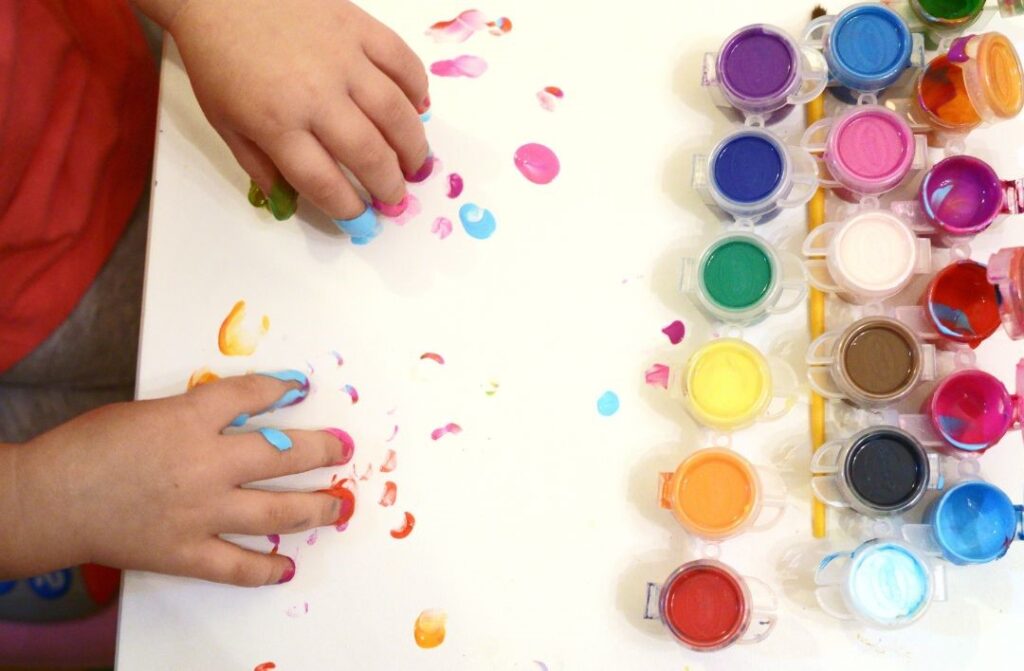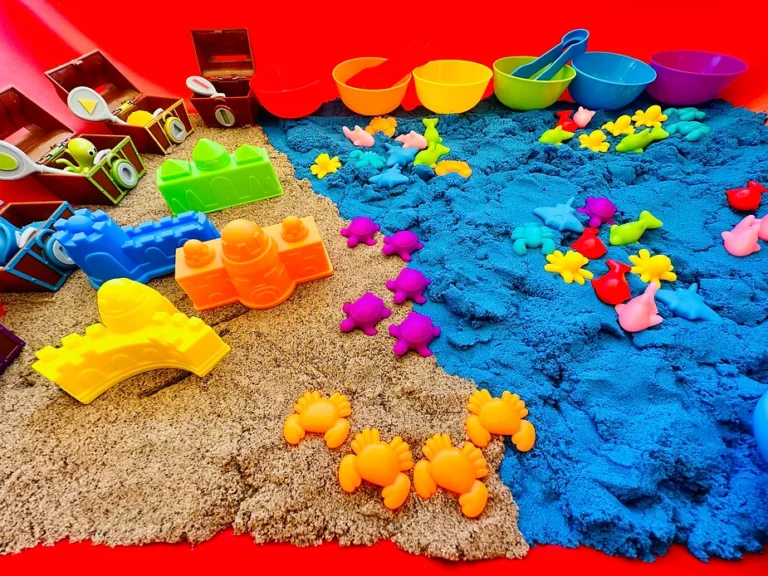Why Sensory Play Is Important For Child Development

Sensory play is not only incredibly fun but also packed with developmental benefits, fostering growth, development, and learning. Learn how sensory activities engage your child’s senses, boost cognitive growth, and enhance emotional regulation with fun, hands-on experiences.
This post may contain affiliate links and I could earn a small commission at no cost to you. However, I will never recommend anything that I do not believe in or use myself. You can read more about my disclosure policy here.
Sensory play isn’t just about keeping kids entertained—it’s a vital part of development. It engages children on multiple levels, from fine-tuning motor skills to building emotional regulation. Sensory play allows kids to explore their world through touch, sight, sound, and even taste.
And here’s something powerful: research shows that sensory-rich activities enhance brain development and cognitive growth in early childhood. That means all those messy playdough sessions and bubble-blowing moments are actually supercharging your child’s brain!
Whether it’s squishing kinetic sand or balancing on a wobble board, sensory play gives children the chance to engage, experiment, and learn. Let’s break it down, explore the benefits, and see how simple activities can have a lasting impact on your child’s growth.
Ready to unlock the benefits? Let’s go!
What Is Sensory Play?
First things first, what exactly is sensory play?
Simply put, sensory play involves activities that stimulate a child’s five senses, plus two additional senses related to balance (vestibular) and body awareness (proprioceptive). It’s a fun and interactive way for kids to explore and understand the world around them. Sensory play can take many forms, including:
Tactile
Any time you see children exploring an object with their hands, they’re using tactile play, such as playing in a sensory bin with playdough, sand, water, or textured fabrics. These activities help children learn about different textures and sensations. This is probably the type of play you’re most likely to think of when we talk about sensory play.
Visual
Visual sensory play helps to develop your child’s vision and sight. Activities that involve sight, such as playing with colorful objects, looking at books, or engaging in visual puzzles. These activities help with visual tracking, color recognition, and spatial awareness.
Proprioceptive
Climbing, jumping, pushing, and pulling heavy objects all help your child develop spatial awareness of their body. These activities help children understand where their bodies are in space. Through proprioception, children learn where they are physically in space and how their limbs relate to the rest of their body.
Vestibular
Activities that involve balance and movement, such as rolling around, hanging, swinging, and jumping. These activities help develop a child’s sense of balance and spatial orientation.
This is because the sense of balance and movement comes from the vestibular system, which is located in the inner ear. Getting a child’s head into as many different positions as possible helps strengthen the vestibular system by activating various receptors in the ear.
Auditory
It might not be your favorite type of play, but auditory play helps your child differentiate sounds and develop their hearing. Activities that involve sound, such as listening to music, playing with noisy toys, or identifying different sounds. These activities help develop listening skills and auditory discrimination.
Olfactory and Taste
Olfactory relates to the sense of smell. It is also directly related to taste. Activities involving the nose such as smelling flowers or a new toy. Activities that involve the mouth such as blowing bubbles, chewing, or using a straw. These activities help strengthen the muscles used for eating and speaking.

Why Has Sensory Play Become So Popular?
1. Easy to Set Up and Adapt
One of the biggest reasons for the popularity of sensory play is how easy it is to set up. With just a few sensory bin items, you can create a fun and engaging play activity. Plus, sensory play is incredibly adaptable to suit any theme or interest your child might have.
For instance, setting up a sensory bin “dinosaur dig” with kinetic sand and plastic dinosaurs, or a “construction site” with gravel, small trucks, and scoops, or a “farmyard” with corn kernels and animal figurines. The possibilities are endless, and you can tailor each sensory activity to your child’s current fascinations, keeping them engaged and excited.
Related: Sensory Bin Supplies: What You Need To Have
2. Encourages Independent Play
Parents love that sensory play can keep children engaged for extended periods. Once set up, kids often dive into the sensory experience, allowing parents a bit of a breather or time to tackle other tasks.
The immersive nature of sensory play means that kids can often entertain themselves, fostering independence and giving parents some much needed downtime. Independent play is crucial for developing self-confidence and problem solving skills in children, and sensory activities offer a safe and engaging way for kids to explore and learn on their own.
Related: How To Make An Awesome Dirty Truck Kids Backyard Play Area
3. Inclusive for All Ages and Abilities
Sensory play is fantastic for children of all ages and developmental stages. Whether you have a toddler just starting to explore the world through touch or an older child who enjoys more complex themes and tasks, sensory activities can be adapted to suit their needs.
It’s particularly beneficial for children with sensory processing disorder or sensory sensitivities, providing a therapeutic and enjoyable activity that can help them feel more grounded. Sensory play can be a soothing and regulating activity, helping them to manage their sensory inputs better.
Related: Common Warning Signs Of Sensory Processing Disorder In Children

The Benefits of Sensory Play
1. Enhances Cognitive Development
Sensory play supports cognitive growth by encouraging children to explore, experiment, and solve problems. As they interact with different materials, they learn about cause and effect, improve their fine motor skills, and develop their creativity.
For example, when a child scoops rice from one container to another, they’re not just playing—they’re learning about volume, quantity, and the physical properties of different materials. This hands-on learning is essential for developing critical thinking and problem-solving skills.
2. Supports Language Development
Describing textures, actions, and experiences during sensory play helps build vocabulary and language skills. Engaging in conversations about what they are doing fosters expressive language development.
Encourage your child to describe what they’re feeling and seeing. Ask open-ended questions like, “How does the sand feel?” or “What do you think will happen if we add water to the rice?” These interactions can significantly boost their descriptive language and communication skills.
Related: How To Create An Awesome Shaving Cream and LEGO Sensory Bin
3. Promotes Social Interaction
When children play together with sensory activities, they learn important social skills like sharing, taking turns, and communicating. This cooperative play is a wonderful way for kids to bond and develop friendships.
Group sensory activities can be especially beneficial. For example, a “treasure hunt” where children work together to find hidden objects encourages teamwork and social interaction. These experiences help children develop empathy, cooperation, and social problem-solving skills.
4. Reduces Anxiety and Enhances Emotional Regulation
The repetitive actions involved in sensory play, such as scooping and pouring, can be soothing and calming for children. This type of play can help reduce anxiety and improve emotional regulation, making it a great tool for managing stress.
Children who struggle with emotional regulation can find sensory play particularly beneficial. The tactile sensations and focused activities can provide a sense of calm and help them manage their emotions more effectively.
Related: How to Create an Awesome Ocean Themed Sensory Bin
5. Improves Focus and Attention
Engaging with sensory activities requires concentration and attention to detail. This focused play can help children develop longer attention spans and improve their ability to focus on tasks.
For instance, finding tiny objects hidden in a sensory bin can require significant focus and patience. This kind of play helps children develop the ability to concentrate on tasks for extended periods, a skill that will serve them well in school and beyond.
Related: 20 Of The Best Classroom Sensory Tools And Quiet Fidget Toys
6. Encourages Sensory Integration
For children with sensory processing disorder or sensory sensitivities, sensory play can be particularly beneficial. It helps them integrate and process different sensory inputs, making it easier for them to navigate the sensory-rich world around them.
Sensory activities can be customized to provide the right level of sensory input, helping children gradually become more comfortable with different textures, sounds, and sights. This gradual exposure can improve their ability to process and respond to sensory information.
Final Thoughts
So there you have it—sensory play is not only incredibly fun but also packed with developmental benefits. Whether you’re looking for an activity to keep your child entertained or a way to support their growth and learning, sensory play is definitely worth trying out.
By embracing the power of sensory play, we’re giving our kids a gift that goes beyond just having fun—it’s about fostering growth, development, and a lifelong love of learning. So join in and watch the magic unfold!
Recommended
- Common Warning Signs Of Sensory Processing Disorder In Children
- Sensory Bin Supplies: What You Need To Have
- How to Create a Sensory Diet for Kids with Sensory Needs?
- How to Create a Calm Down Corner for Autism






